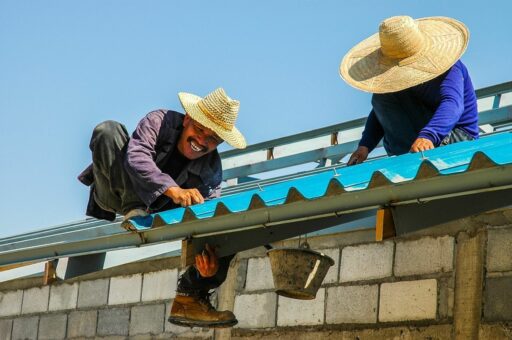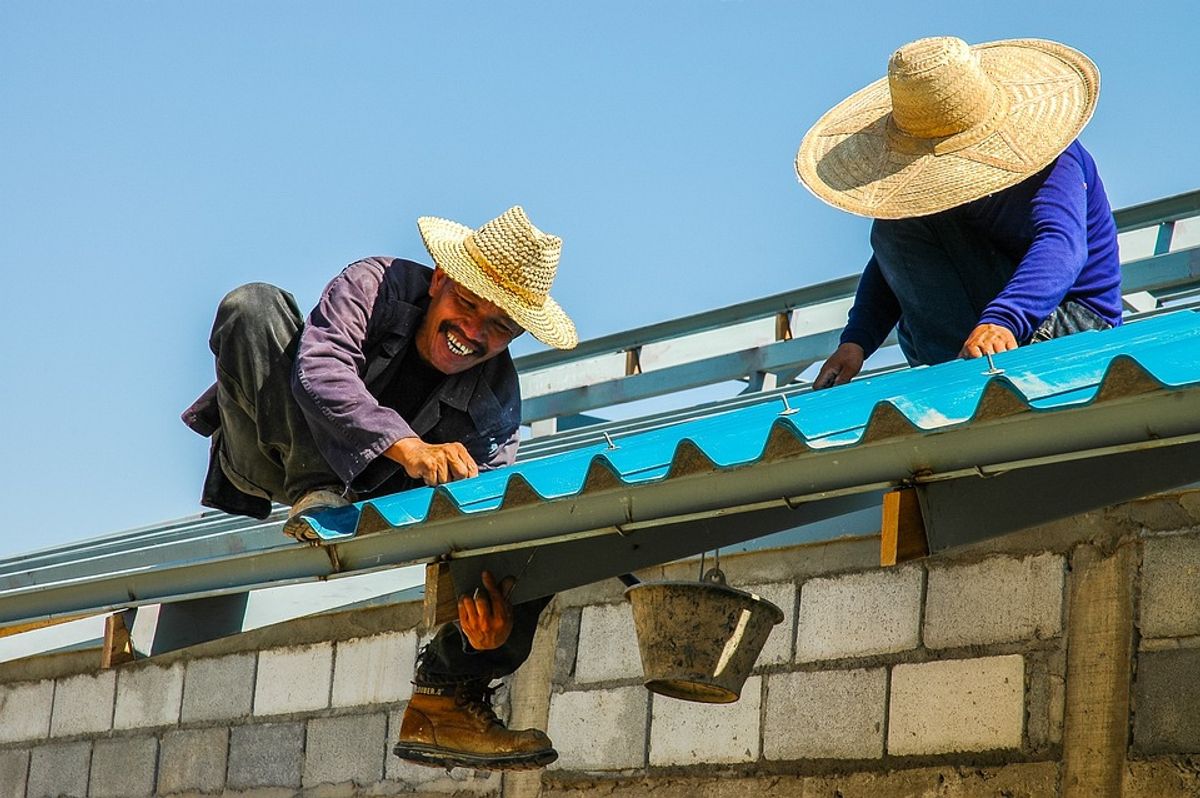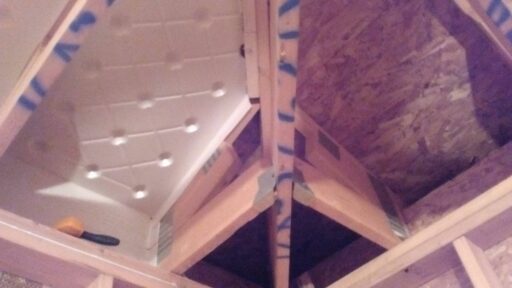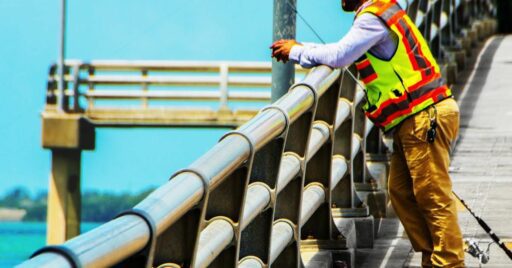When it comes to home renovation, selecting the right roofing material is pivotal for ensuring durability, energy efficiency, and aesthetic appeal. Metal roofing has emerged as a superior option for homeowners due to its resilience against extreme weather, energy-saving capabilities, and longevity. In this comprehensive guide, we’ll explore the nuances of metal roofing, why it’s an excellent choice for your home, how to choose the best metal roof contractors, and how to maximize your investment in metal roofing.
Key Takeaways
- Metal roofing offers a range of options including tiles, shingles, and shakes, catering to different aesthetic preferences and functional requirements.
- The energy efficiency of metal roofing can be maximized with advanced underlayments, proper installation methods, and high-quality materials.
- Selecting a reputable metal roof contractor is crucial; look for qualities such as experience, a solid portfolio, and positive testimonials within networks like DECRA.
- Regional considerations are important when choosing metal roofing, as the best options may vary depending on climate and the potential for natural disasters.
- Investing in metal roofing can enhance home resale value, and understanding warranties and insurance options is essential for protecting this investment.
Understanding Metal Roofing

What is Metal Roofing?
Metal roofing is a highly durable and energy-efficient roofing solution that has gained popularity among homeowners. Metal roofs are known for their longevity, resistance to extreme weather, and ability to reflect solar radiation, which can lead to significant energy savings. Unlike traditional asphalt shingles, metal roofing materials come in various forms such as tiles, shingles, and shakes, each offering a unique aesthetic and functional benefits.
Metal roofing systems can reduce energy costs by up to 40%, making them an excellent choice for those looking to enhance their home’s energy efficiency.
The installation of metal roofing can vary, impacting ventilation and overall energy efficiency. It’s essential to consider the type of underlayment used, as this can affect heat transfer and further improve energy performance. For instance, upgrading from standard asphalt-saturated felt to more advanced options can make a noticeable difference.
Types of Metal Roofing: Tiles, Shingles, and Shakes
Metal roofing comes in various forms, each offering unique benefits and aesthetic options for homeowners. Metal tile roofing is known for its traditional and elegant appearance, often resembling classic clay tiles. Metal shingle roofing, on the other hand, provides a look similar to conventional asphalt shingles but with the added durability and longevity of metal.
Metal shake roofing captures the rustic charm of wood shakes, yet it stands up to the elements far better than wood. These metal shingles are coated in paint and stone granules to mimic the look of asphalt shingles, wood shakes, or clay tiles. The choice between tiles, shingles, and shakes often comes down to personal preference, the architectural style of the home, and budget considerations.
When selecting the type of metal roofing, consider not only the aesthetic appeal but also the functional benefits, such as energy efficiency and resistance to extreme weather conditions.
Installation methods for metal roofing can affect ventilation and, consequently, the building’s energy efficiency. It’s essential to discuss with your contractor the best underlayment and installation practices to maximize the performance of your metal roof.
The Energy Efficiency of Metal Roofing
Metal roofing stands out as a superior choice for those seeking to enhance their home’s energy efficiency. With the potential to cut energy costs by up to 40%, metal roofs are not only cost-effective but also environmentally friendly. The high emissivity of metal roofs contributes to keeping buildings cooler, as they reflect heat away rather than absorbing it like traditional asphalt shingles.
The installation method of metal roofing plays a crucial role in its energy efficiency. Proper ventilation and advanced underlayments can significantly boost the performance of a metal roof.
There are primarily two installation methods that affect energy efficiency:
- Batten installations, which include an additional layer of ventilation, and
- Direct-to-deck installations, which still offer considerable energy savings, particularly when paired with lighter-colored roofs for increased heat reflection.
Selecting the right materials and installation techniques can maximize the energy-saving benefits of metal roofing, making it an ideal choice for homeowners prioritizing energy efficiency.
Why Choose Metal Roofing for Your Home

Durability Against Extreme Weather
Metal roofing stands as a paragon of resilience, especially when faced with the wrath of Mother Nature. Its ability to withstand extreme weather conditions is a key factor in its growing popularity among homeowners. From heavy snowfall to fierce winds, metal roofs are engineered to provide superior protection compared to traditional roofing materials.
- Resistance to Wind: Metal roofs can endure wind gusts that far exceed the capabilities of conventional shingles.
- Snow and Ice: The slick surface of metal roofs allows snow and ice to slide off, preventing build-up and potential damage.
- Heat and Sun: Reflective coatings on metal roofs deflect sunlight, reducing heat absorption and mitigating the effects of UV radiation.
Metal roofing’s durability is not just about enduring the elements; it’s also about maintaining its integrity over time without the need for frequent repairs or replacements. This aspect of metal roofing is particularly appealing to those looking to invest in a long-term solution for their home.
When considering a metal roof, it’s important to partner with contractors who have a proven track record of quality installations. The Best Contractors website, for instance, emphasizes the importance of choosing contractors with expertise in systems like Duro-Last, which are renowned for their durability and performance in residential and commercial settings.
Enhancing Home Energy Efficiency
Metal roofing stands out as a superior choice for homeowners aiming to enhance their home’s energy efficiency. Understanding how thermal performance works is crucial, as it informs how the roofing system’s components can improve overall energy performance. This includes advanced underlayments and installation methods designed to maximize airflow and ventilation.
For those prioritizing energy efficiency, it’s essential to know that metal roofing’s efficiency can be further boosted with the right materials and techniques. If maximum energy efficiency is your goal, consider the following upgrades to push the performance of your metal roof:
- Advanced underlayments that enhance the roof’s thermal resistance by reducing heat transfer.
- Installation methods that increase the airspace beneath the roofing, improving heat emission and promoting efficient temperature regulation.
In roofing, energy efficiency is measured by three key physical characteristics, known as thermal performance. These characteristics are pivotal in determining how well your roof can maintain a comfortable indoor climate while minimizing energy consumption.
Longevity and Aesthetic Appeal
One of the standout features of metal roofing is its remarkable longevity. While traditional asphalt shingles may need replacement every 15 to 20 years, metal roofs can last 40 to 70 years or more, depending on the material and installation quality. This durability translates into significant cost savings over time, as the need for frequent replacements is greatly reduced.
Metal roofing also offers a wide range of aesthetic options to complement any architectural style. From the sleek, modern look of standing seam panels to the traditional appearance of metal shingles or tiles, homeowners can select from a variety of colors and finishes to enhance their home’s curb appeal.
To ensure the longevity and aesthetic appeal of your metal roof, consider these points:
- Choose high-quality materials designed for your climate.
- Ensure proper installation by hiring experienced professionals.
- Follow the manufacturer’s guidelines for maintenance.
- Add protective coatings or finishes to boost durability and appearance.
By taking the time to research and select the right materials and professionals, your investment in metal roofing will not only improve the visual appeal of your home but also provide lasting protection and value.
Selecting the Right Metal Roof Contractor

Qualities of a Reputable Metal Roof Contractor
When selecting a metal roof contractor, it’s crucial to look for certain qualities that ensure a high standard of work and reliability. Experience and expertise in the field of metal roofing are fundamental. A contractor with a solid track record of successful installations is more likely to deliver quality results.
- Certifications and Licensing: Verify that the contractor holds all necessary certifications and is licensed to operate in your area.
- Insurance and Bonding: Ensure that the contractor is insured and bonded to protect against any accidents or damage during the project.
- References and Reviews: Look for contractors with positive customer feedback and ask for references to gauge their reputation.
A reputable contractor will not only offer a competitive quote but also provide a detailed explanation of the work to be done, including the materials and timeline. Transparency in communication and costs is key to a successful partnership.
Finally, consider the contractor’s commitment to ongoing education and staying updated with the latest industry standards and technology. This dedication often translates into better service and innovative solutions for your metal roofing needs.
The DECRA Contractor Network
When selecting a metal roof contractor, the DECRA Contractor Network stands out as a premier choice for homeowners. DECRA has been a leading name in stone-coated metal roofing since 1957, combining industrial durability with architectural beauty. By choosing a DECRA-certified contractor, you are ensuring that your roofing project is handled by professionals trained in the latest installation techniques and product knowledge.
The DECRA Contractor Network is not just about quality installation; it’s a commitment to excellence that extends beyond the roof itself.
Joining the DECRA network is a mark of distinction for contractors, signifying their dedication to superior craftsmanship and customer satisfaction. Homeowners can benefit from the peace of mind that comes with a comprehensive Lifetime Limited Warranty, which is a standard offering for DECRA roofing products.
- Qualifications: Contractors must meet stringent requirements to join.
- Training: Ongoing education ensures they are up-to-date with the latest standards.
- Support: DECRA provides contractors with resources like a ventilation calculator and knowledge base.
- Recognition: Members can earn accolades, such as the DECRA Metal Roofing Project of the Year Award.
Evaluating Contractor Portfolios and Testimonials
When selecting a metal roof contractor, carefully reviewing their portfolio is crucial. A portfolio showcases the contractor’s previous work and gives you insight into their craftsmanship and experience. Look for a variety of projects that demonstrate versatility and skill in metal roofing.
Testimonials and reviews from past clients are equally important. They provide an honest assessment of the contractor’s reliability, communication, and overall service quality. Here’s a simple list to guide you through the evaluation process:
- Research and compare roofing contractors.
- Verify licenses, insurance, and accreditations.
- Examine the diversity and quality of past projects.
- Read client testimonials and online reviews.
- Check for any awards or recognitions in the industry.
Remember, a reputable contractor will be transparent about their work history and happy to provide references. Don’t hesitate to reach out to previous clients to discuss their experiences firsthand.
Regional Considerations for Metal Roofing

Best Metal Roof Options for Different Climates
Choosing the right metal roof for your home involves considering the climate you live in. Metal roofing is versatile and can be adapted to various environmental conditions, ensuring your home stays protected and energy-efficient year-round.
For homeowners in hurricane-prone areas, certain types of metal roofing are more suitable. Metal tile, shingle, and shake roofing are all viable options, each with unique benefits. Metal tile roofing, for instance, is known for its resilience and ability to withstand high winds and driving rain, making it an ideal choice for coastal regions.
- Metal Tile Roofing: Excellent for high wind resistance.
- Metal Shingle Roofing: Combines durability with traditional aesthetics.
- Metal Shake Roofing: Offers a rustic look with robust protection.
When selecting a metal roof, it’s crucial to balance aesthetic preferences with functional requirements to achieve the best outcome for your home.
In areas with high salt concentration, like those near the ocean, corrosion resistance becomes a key factor. Metal roofing materials that perform well in salt water environments can significantly extend the lifespan of your roof.
Protecting Your Home from Natural Disasters
When it comes to safeguarding your home from the ravages of natural disasters, metal roofing stands out as a resilient choice. Metal roofs are known for their ability to withstand severe weather conditions, including high winds, hail, and even fire. The inherent strength and durability of metal roofing materials make them an ideal protective barrier for your home.
- Wind Resistance: Metal roofs can resist wind speeds that often cause traditional shingles to fail.
- Hail Protection: The impact resistance of metal roofs protects against hail damage, which can be costly to repair.
- Fire Safety: Metal roofs are noncombustible, offering an added layer of protection in fire-prone areas.
By choosing a metal roof, homeowners not only enhance the safety of their dwelling but also potentially reduce insurance premiums due to the increased durability and protection offered.
It’s crucial to select a metal roof that is appropriate for your specific region and the natural disasters most common to it. For instance, in areas prone to hurricanes, a metal roof system designed to resist uplift from high winds would be essential. Similarly, in regions with heavy snowfall, a roof with a strong load-bearing capacity is necessary to prevent collapse.
Metal Roofing and Solar Energy Integration
Integrating solar panels with metal roofing is a match made in heaven for homeowners aiming for peak energy efficiency. Metal roofs provide an ideal platform for solar panel installation, offering a durable and long-lasting base. Unlike traditional roofing materials, metal roofs can enhance the performance of solar panels by improving air flow and ventilation when installed correctly.
There are two primary installation methods for metal roofs that can affect energy efficiency:
- Direct-to-deck installation
- Batten installation
Direct-to-deck installations are straightforward and still yield significant energy savings, particularly when paired with lighter colored roofs that reflect more heat. Batten installations add an extra layer of ventilation, which can further improve energy efficiency.
To achieve the highest level of energy efficiency, consider advanced underlayments and cutting-edge materials in addition to the installation method. These components work together to optimize the thermal performance of your roofing system.
When selecting a metal roof for solar integration, it’s crucial to understand the impact of installation techniques and material choices on energy efficiency. By doing so, homeowners can ensure they are making the most of their investment and contributing to a more sustainable future.
Maximizing Your Investment in Metal Roofing

Understanding Warranties and Insurance
When investing in a metal roof, understanding the warranties and insurance that accompany your purchase is crucial. Manufacturers’ warranties typically cover roofing materials against defects or failures for the expected life span of the product. It’s important to read the fine print and know what is included in your coverage.
- Manufacturer’s Warranty: Guarantees the quality of roofing materials.
- Workmanship Warranty: Offered by contractors, covering installation.
- Insurance Claim Assistance: Some contractors guide you through the process.
Ensuring that both material and workmanship warranties are in place can provide peace of mind and protect your investment in the long term.
Always verify the contractor’s insurance to safeguard against any potential damage or accidents during installation. A reputable contractor will have comprehensive liability insurance and workers’ compensation in place.
Historic Renovation with Metal Roofing
Renovating historic homes requires a delicate balance between preserving the past and embracing modern benefits. Metal roofing is an excellent choice for historic renovation as it can mimic traditional materials while providing enhanced durability and energy efficiency. When upgrading to sustainable roofing, homeowners not only contribute to the preservation of historical aesthetics but also gain energy savings and a reduced carbon footprint.
- Consider the local climate and select a metal roofing style that complements the historic character.
- Choose contractors with experience in historic renovations to ensure the integrity of the original design is maintained.
- Benefits of metal roofing in historic renovation include improved energy efficiency, increased home value, safety, and access to warranties.
Metal roofing allows for a seamless integration of tradition and innovation, ensuring that historic homes meet contemporary standards without losing their timeless appeal.
The Impact of Metal Roofing on Home Resale Value
Investing in metal roofing can significantly impact the resale value of your home. Eco-friendly roofing options enhance property value, offering a compelling selling point for environmentally conscious buyers. Metal roofs are not only durable but also contribute to the aesthetic appeal of your home, which is crucial for first impressions during a sale.
When considering the resale value, it’s important to choose materials that are both visually appealing and energy-efficient. The condition of the roof is a key factor in curb appeal and can greatly influence a potential buyer’s decision. A well-maintained metal roof suggests a home that has been cared for, potentially leading to a higher resale value.
Metal roofing can be a smart investment for homeowners looking to improve their home’s energy efficiency and aesthetic appeal, while also potentially increasing its market value.
Here’s a quick overview of how different roofing options compare in terms of enhancing home value:
- Asphalt Shingles: Affordable, versatile, available in various colors and styles.
- Metal Roofing: Durable, energy-efficient, and can improve home resale value.
- Gutters: Choices like aluminum, copper, and steel can complement the roofing material and contribute to the home’s overall appeal.
Conclusion
Choosing the right metal roof contractor for your home renovation is a pivotal decision that can influence both the aesthetic appeal and the resilience of your home. With the insights provided in this article, homeowners are equipped to make informed choices, considering factors like energy efficiency, durability in extreme weather, and the unique needs of their region. Metal roofing stands out as a superior option for those seeking a blend of longevity, energy savings, and style. By engaging with reputable contractors, ensuring the use of advanced materials and installation methods, and considering the environmental benefits, you can elevate the energy efficiency and overall value of your home. Remember, the best roof is one that not only looks great but also offers peace of mind through its strength and efficiency. Take the time to research and select a contractor from the DECRA Contractor Network who aligns with your vision and can bring your home renovation project to life with excellence.
Frequently Asked Questions
What are the benefits of choosing metal roofing over traditional materials?
Metal roofing offers several benefits such as durability against extreme weather, energy efficiency, longevity, and aesthetic appeal. It is resistant to fire, wind, hail, and can also be energy-efficient, reducing energy costs by up to 40%.
What types of metal roofing are available?
There are various types of metal roofing available, including metal tiles, shingles, and shakes. Each type offers a unique look and feel for your home renovation, catering to different styles and preferences.
How does metal roofing contribute to a home’s energy efficiency?
Metal roofing reflects solar radiant heat, which can reduce cooling costs in the summer. Additionally, with advanced underlayments and installation methods, the energy efficiency of metal roofing can be maximized, potentially leading to significant savings on energy bills.
What should I look for in a metal roof contractor?
When selecting a metal roof contractor, look for qualities such as experience, a solid portfolio, positive testimonials, and membership in reputable networks like the DECRA Contractor Network. Ensure they are licensed, insured, and have a good track record.
Are there any regional considerations when choosing metal roofing?
Yes, depending on your climate, you may need to choose a metal roof that is best suited for conditions such as heavy snow, hurricanes, or hail. Some metal roofing options are also compatible with solar energy integration, which can be beneficial in sunny regions.
How does metal roofing affect a home’s resale value?
Metal roofing can positively impact a home’s resale value due to its durability, longevity, and energy efficiency. It is a desirable feature for potential buyers who are looking for a home with a roof that requires minimal maintenance and offers cost savings over time.





